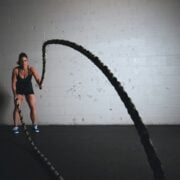
Get the Most Out of Your Crunches: Tips for Proper Form and Maximum Results
Crunches are a popular exercise for building strong abs and achieving a toned midsection. They target the rectus abdominis, the muscle responsible for the “six-pack” appearance, as well as the obliques, which help with twisting and bending movements. While crunches may seem simple, it is important to perform them with proper form to avoid injury and maximize their effectiveness. In this article, we will explore the importance of proper form in crunches, the muscles targeted during this exercise, how to choose the right surface for your crunches, and advanced variations to try.
Key Takeaways
- Proper form is crucial for effective and safe crunches.
- Crunches primarily target the rectus abdominis and obliques.
- A stable surface, such as a mat or bench, is best for performing crunches.
- Basic crunches involve lifting the shoulders off the ground while keeping the lower back pressed into the floor.
- Advanced variations of crunches, such as bicycle crunches and reverse crunches, can add variety and challenge to your routine.
The Importance of Proper Form in Crunches
Proper form is crucial when performing crunches to ensure that you are targeting the intended muscles and avoiding strain on other parts of your body. One of the most common mistakes people make during crunches is pulling on their neck or using their hands to lift their upper body. This can lead to strain on the neck and back, and it takes away from the effectiveness of the exercise.
To perform crunches with proper form, lie on your back with your knees bent and feet flat on the ground. Place your hands lightly behind your head, but avoid pulling on your neck. Engage your core muscles by drawing your belly button towards your spine. Lift your upper body off the ground by curling your shoulders towards your hips, while keeping your lower back pressed into the floor. Exhale as you lift and inhale as you lower back down.
Understanding the Muscles Targeted in Crunches
Crunches primarily target the rectus abdominis, which is responsible for flexing the spine and creating that coveted six-pack appearance. However, they also engage the obliques, which are located on the sides of your abdomen and help with twisting and bending movements.
Strengthening these muscles can improve overall core strength and stability. A strong core is essential for maintaining proper posture, preventing lower back pain, and performing everyday activities with ease. Additionally, a strong core can enhance athletic performance in sports that require rotational movements, such as golf or tennis.
Choosing the Right Surface for Your Crunches
| Surface Type | Pros | Cons |
|---|---|---|
| Exercise Mat | Provides cushioning for joints, easy to clean, portable | May slip on smooth surfaces, not suitable for high impact exercises |
| Carpet | Provides some cushioning, non-slip surface | May cause friction burns, difficult to clean, not suitable for high impact exercises |
| Hardwood Floor | Provides a stable surface, easy to clean | May cause discomfort on joints, not suitable for high impact exercises |
| Yoga Mat | Provides cushioning for joints, non-slip surface, portable | May not be suitable for high impact exercises, may wear out quickly |
| Concrete Floor | Provides a stable surface, easy to clean | May cause discomfort on joints, not suitable for high impact exercises |
Choosing the right surface for your crunches is important to ensure stability and comfort during the exercise. A stable surface will allow you to focus on engaging your core muscles without worrying about slipping or sliding.
A yoga mat is a popular choice for performing crunches as it provides cushioning and grip. It also helps to protect your back from the hard floor. If you prefer a firmer surface, an exercise bench can be a good option. Make sure the bench is stable and secure before using it for crunches.
How to Perform Basic Crunches with Proper Form
To perform basic crunches with proper form, follow these step-by-step instructions:
1. Lie on your back with your knees bent and feet flat on the ground.
2. Place your hands lightly behind your head, but avoid pulling on your neck.
3. Engage your core muscles by drawing your belly button towards your spine.
4. Lift your upper body off the ground by curling your shoulders towards your hips.
5. Exhale as you lift and inhale as you lower back down.
6. Repeat for the desired number of repetitions.
It is important to note that you should not lift your entire back off the ground during crunches. The movement should be focused on curling your shoulders towards your hips while keeping your lower back pressed into the floor.
Advanced Variations of Crunches to Try

Once you have mastered basic crunches, you can try advanced variations to target different areas of the abs and increase the intensity of the exercise.
One variation is the bicycle crunch, which targets both the rectus abdominis and obliques. To perform this exercise, lie on your back with your knees bent and feet off the ground. Place your hands lightly behind your head and lift your upper body off the ground. Bring your right elbow towards your left knee while extending your right leg straight out. Switch sides, bringing your left elbow towards your right knee while extending your left leg straight out. Continue alternating sides in a pedaling motion.
Another variation is the reverse crunch, which targets the lower abs. Lie on your back with your legs extended straight up towards the ceiling. Place your hands by your sides or under your hips for support. Engage your core muscles and lift your hips off the ground, bringing your knees towards your chest. Lower back down with control and repeat.
Common Mistakes to Avoid During Crunches
There are several common mistakes people make when performing crunches that can lead to injury or reduce the effectiveness of the exercise. One of the most common mistakes is pulling on the neck or using momentum to lift the upper body. This can strain the neck and back and take away from the targeted muscle engagement.
To avoid these mistakes, focus on using your core muscles to lift your upper body rather than relying on momentum or pulling on your neck. Keep your movements slow and controlled, and exhale as you lift and inhale as you lower back down.
Tips for Increasing the Intensity of Your Crunches
If you find that basic crunches are becoming too easy, there are several ways to increase the intensity of the exercise. One option is to add weights. Hold a dumbbell or weight plate against your chest while performing crunches to increase resistance and challenge your muscles.
Another option is to increase the number of repetitions or sets. Gradually increase the number of crunches you perform in each set, or add an additional set to your workout routine.
It is important to gradually increase intensity to avoid injury. Listen to your body and only increase the intensity when you feel ready. If you experience any pain or discomfort, stop and consult a fitness professional.
Incorporating Other Abdominal Exercises into Your Routine
While crunches are an effective exercise for building strong abs, it is beneficial to incorporate other abdominal exercises into your routine to target different areas of the abs and improve overall core strength.
Plank exercises, such as forearm plank or side plank, engage the entire core and can help improve stability and endurance. Russian twists target the obliques and can be performed with or without weights. Leg raises target the lower abs and can be performed lying on your back or hanging from a pull-up bar.
By incorporating a variety of abdominal exercises into your routine, you can ensure that you are targeting all areas of your abs and achieving a well-rounded core workout.
Making the Most of Your Crunches for Stronger Abs
In conclusion, crunches are an effective exercise for building strong abs and achieving a toned midsection. However, it is important to perform them with proper form to avoid injury and maximize their effectiveness. Focus on engaging your core muscles and avoid pulling on your neck or using momentum to lift your upper body.
In addition to basic crunches, there are advanced variations that can target different areas of the abs and increase the intensity of the exercise. By gradually increasing the intensity and incorporating other abdominal exercises into your routine, you can achieve stronger, more defined abs.
Remember to listen to your body and only increase intensity when you feel ready. If you experience any pain or discomfort, stop and consult a fitness professional. With proper form, consistency, and a well-rounded workout routine, you can make the most of your crunches and achieve your desired results.
FAQs
What are crunches?
Crunches are a type of exercise that targets the abdominal muscles. It involves lying on your back with your knees bent and feet flat on the ground, then lifting your upper body towards your knees.
What are the benefits of doing crunches?
Crunches can help strengthen and tone your abdominal muscles, improve your posture, and reduce the risk of back pain.
How do I do crunches correctly?
To do crunches correctly, lie on your back with your knees bent and feet flat on the ground. Place your hands behind your head, keeping your elbows out to the sides. Lift your upper body towards your knees, keeping your neck and head in a neutral position. Exhale as you lift up and inhale as you lower back down.
How many crunches should I do?
The number of crunches you should do depends on your fitness level and goals. It’s important to start with a manageable number and gradually increase as you get stronger. Aim for 2-3 sets of 10-15 reps.
Can I do crunches every day?
It’s generally safe to do crunches every day, but it’s important to listen to your body and avoid overtraining. It’s also important to incorporate other exercises that target different muscle groups for a well-rounded workout.
What are some common mistakes to avoid when doing crunches?
Common mistakes to avoid when doing crunches include pulling on your neck, using momentum to lift your upper body, and arching your back. It’s important to keep your movements slow and controlled, and focus on engaging your abdominal muscles.


















